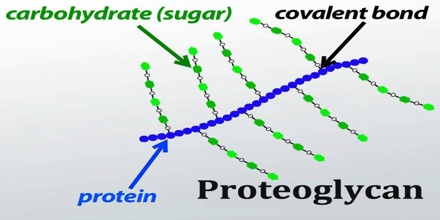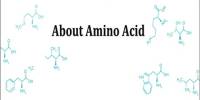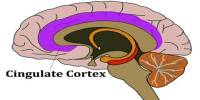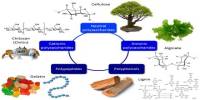Proteoglycan
Definition
Proteoglycan is any of a group of polysaccharide-protein conjugates present in connective tissue and cartilage, consisting of a polypeptide backbone to which many glycosaminoglycan chains are covalently linked; they form the ground substance in the extracellular matrix of connective tissue and also have lubricant and support functions. Proteoglycans make up a major part of the extracellular matrix, the material between cells that provides structural support. Unlike in other body tissues, the extracellular matrix is the most important part of connective tissue.

Proteoglycans are heavily glycosylated glycoproteins. This means that they are proteins with chains of polysaccharides, a kind of carbohydrate, attached. The point of attachment is a serine (Ser) residue to which the glycosaminoglycan is joined through a tetrasaccharide bridge. The Ser residue is generally in the sequence -Ser-Gly-X-Gly-, where X can be any amino acid residue but proline, although not every protein with this sequence has an attached glycosaminoglycan.
Proteoglycans are negatively charged because of the presence of sulfates and uronic acids. The GAG chains of a proteoglycan may be made of chondroitin sulfate, dermatan sulfate, heparin sulfate, heparan sulfate, or keratan sulfate. It helps to provide us with clues to the molecule’s chemical composition. As such, a proteoglycan is a long polysaccharide (sugar) chain covalently attached to a protein and produced in the endoplasmic reticulum (ER), a specialized organelle.
Structure and Functions of Proteoglycans
Proteoglycans can be categorized by size. Large molecules include aggrecan, an important component of cartilage, and versican, which is found in the blood vessels and skin. All components of a proteoglycan are synthesized within cells. The protein portion is synthesized by ribosomes, which make proteins out of amino acids. The protein is then moved to the rough endoplasmic reticulum (RER). It is glycosylated in the Golgi apparatus, another organelle, in a number of steps.

Proteoglycans are a major component of the animal extracellular matrix, the “filler” substance existing between cells in an organism. The combination of proteoglycans and collagen form cartilage, a sturdy tissue that is usually heavily hydrated. They are also involved in binding cations, such as sodium, potassium and calcium and water, and also regulating the movement of molecules through the matrix
A group of genetic metabolic disorders known as mucopolysaccharidoses are characterized by the inability to break down proteoglycans due to absent or malfunctioning lysosomal enzymes. These disorders lead to a proteoglycan buildup in the cells.
Reference: thefreedictionary.com, wisegeek.com, wikipedia.
















